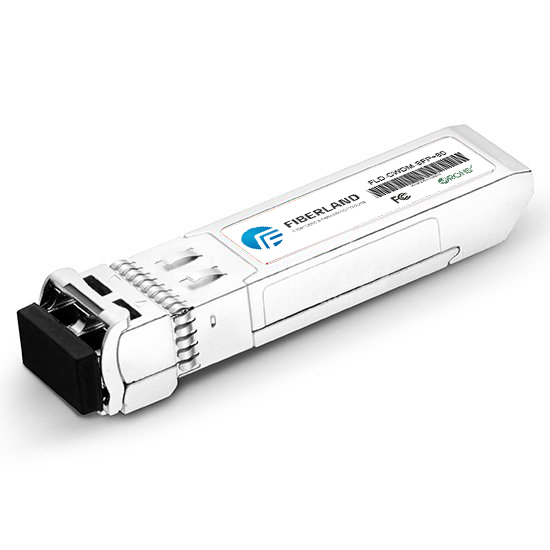How to Test the SFP+ module?
2017-06-14
A sfp module can be inserted into a switch or router in order to connect other networking devices or uplinks. The SFP slot is versatile, because you can purchase SFPs with a wide variety of different connection types.

1、Type "show interface status" from the privileged mode of the device.
2、Look for the line associated with the interface number of the SFP slot you are troubleshooting. The last column, "Type," indicates what type of SFP module is in the SFP slot. If "Type" says "No SFP," then the Cisco device does not recognize the SFP. This could indicate faulty hardware or a poor connection.
3、 Remove the SFP, check for foreign objects in the SFP slot, firmly replace the SFP into the slot and check it again.
4、Replace the SFP and check it again. If the new SFP module works, the old SFP is faulty and needs to be replaced, or it is a SFP module that is not compatible with this switch. Non-Cisco SFPs will not always work in Cisco switches, and are not recommended by Cisco.
5、Place the SFP module into another SFP slot and check it again, this time looking at the line for the new interface. If the SFP module works in a different SFP slot, the original SFP slot is likely to be faulty and the switch itself may be defective.
6、Verify the SFP module is transmitting a signal by connecting a patch cord to it and plugging the other end into another switch. From the other switch, establish a terminal console and run the command "show interface status." Verify the "Status" column indicates a "connected" state. If both switches show a "connected" status for the link used with your SFP module, the SFP module is transmitting and receiving data.
7、Verify the fault does not lie with the patch cable or cables used between the two switches by connecting the patch cables to a known good SFP module or by replacing the patch cables with known good cables.

1、Type "show interface status" from the privileged mode of the device.
2、Look for the line associated with the interface number of the SFP slot you are troubleshooting. The last column, "Type," indicates what type of SFP module is in the SFP slot. If "Type" says "No SFP," then the Cisco device does not recognize the SFP. This could indicate faulty hardware or a poor connection.
3、 Remove the SFP, check for foreign objects in the SFP slot, firmly replace the SFP into the slot and check it again.
4、Replace the SFP and check it again. If the new SFP module works, the old SFP is faulty and needs to be replaced, or it is a SFP module that is not compatible with this switch. Non-Cisco SFPs will not always work in Cisco switches, and are not recommended by Cisco.
5、Place the SFP module into another SFP slot and check it again, this time looking at the line for the new interface. If the SFP module works in a different SFP slot, the original SFP slot is likely to be faulty and the switch itself may be defective.
6、Verify the SFP module is transmitting a signal by connecting a patch cord to it and plugging the other end into another switch. From the other switch, establish a terminal console and run the command "show interface status." Verify the "Status" column indicates a "connected" state. If both switches show a "connected" status for the link used with your SFP module, the SFP module is transmitting and receiving data.
7、Verify the fault does not lie with the patch cable or cables used between the two switches by connecting the patch cables to a known good SFP module or by replacing the patch cables with known good cables.
RECENT BLOG POST
-
012019-10With the continuous development of 5G communication technology, 100G modules are gradually becoming popular. We know that there are many kinds of packages for 100G optical modules. From 2000 to now, the optical module package types have been rapidly developed. Its main package types are: GBIC, SFP, XENPAK, SNAP12, X2, XFP, SFP+, QSFP/QSFP+, CFP, CXP. In the fast-developing network era, some 100G optical modules avoid the risk of being eliminated, and upgraded and revised with the wave of the Internet, such as 100G CFP optical modules.
-
012019-101. What is the CWDM SFP? The CWDM optical module is an optical module using CWDM technology to implement the connection between the existing network device and the CWDM multiplexer/demultiplexer. When used with a CWDM multiplexer/demultiplexer, CWDM optical modules can increase network capacity by transmitting multiple data channels with separate optical wavelengths (1270 nm to 1610 nm) on the same single fiber.
-
012019-10AOC is the abbreviation of Active Optical Cables, which is called Active Optical Cables in Chinese. AOC active optical is to encapsulate two optical modules and cable together. Because the medium of transmission in the middle is optical cable, AOC optical module, which contains laser devices, has a higher price for DAC. However, its optical aperture is not exposed, it has high reliability, and its working distance can be customized for a long distance of less than 100 meters.
-
012019-10Dense Wavelength Division Multiplexing (DWDM) technology is capable of transmitting data in an optical fiber using bit wavelength parallel transmission or string line transmission using the wavelength of the laser.It is widely used in different fields of communication networks, including long-distance backbone networks, metropolitan area networks (MANs), residential access networks, and local area networks (LANs).The DWDM optical module is the optical module that uses this technology, so the DWDM optical module has high bandwidth and long-distance transmission characteristics.












